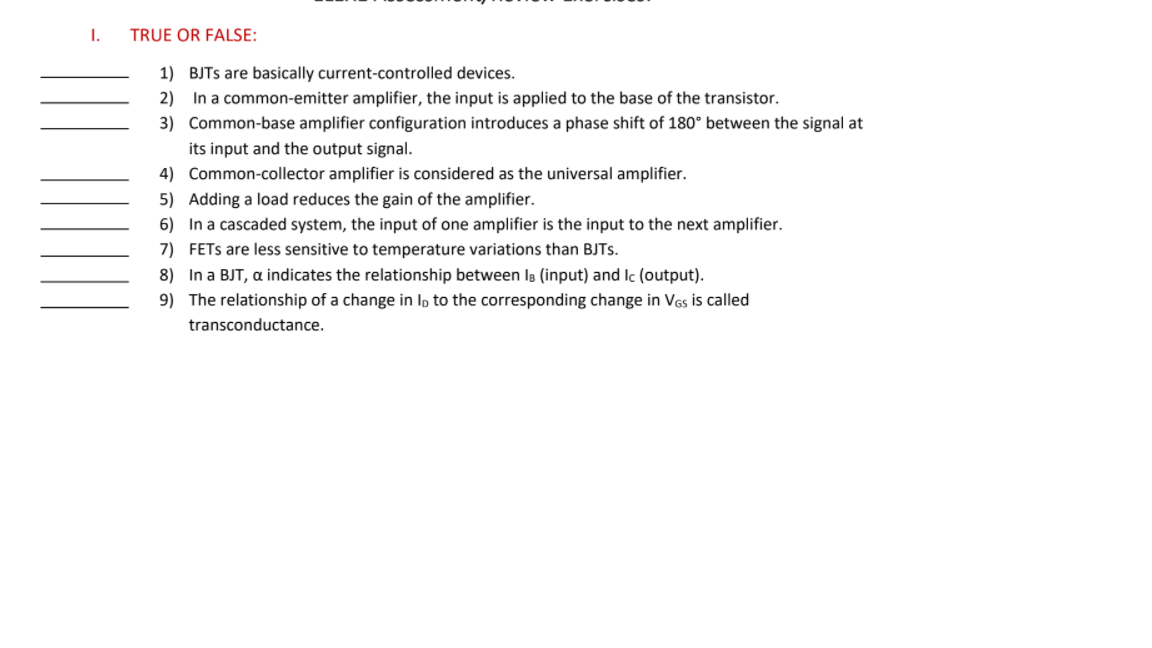I. TRUE OR FALSE: 1) BJTS are basically current-controlled devices. 2) In a common-emitter amplifier, the input is applied to the base of the transistor. 3) Common-base amplifier configuration introduces a phase shift of 180° between the signal at its input and the output signal. 4) Common-collector amplifier is considered as the universal amplifier. 5) Adding a load reduces the gain of the amplifier. 6) In a cascaded system, the input of one amplifier is the input to the next amplifier. 7) FETS are less sensitive to temperature variations than BJTs. 8) In a BJT, a indicates the relationship between Is (input) and Ic (output). 9) The relationship of a change in Ip to the corresponding change in Vas is called transconductance.
I. TRUE OR FALSE: 1) BJTS are basically current-controlled devices. 2) In a common-emitter amplifier, the input is applied to the base of the transistor. 3) Common-base amplifier configuration introduces a phase shift of 180° between the signal at its input and the output signal. 4) Common-collector amplifier is considered as the universal amplifier. 5) Adding a load reduces the gain of the amplifier. 6) In a cascaded system, the input of one amplifier is the input to the next amplifier. 7) FETS are less sensitive to temperature variations than BJTs. 8) In a BJT, a indicates the relationship between Is (input) and Ic (output). 9) The relationship of a change in Ip to the corresponding change in Vas is called transconductance.
Chapter25: Television, Telephone, And Low-voltage Signal Systems
Section25.1: Television Circuit
Problem 5R: From a cost standpoint, which system is more economical to install: a master amplifier distribution...
Related questions
Question

Transcribed Image Text:I.
TRUE OR FALSE:
1) BJTS are basically current-controlled devices.
2) In a common-emitter amplifier, the input is applied to the base of the transistor.
3) Common-base amplifier configuration introduces a phase shift of 180° between the signal at
its input and the output signal.
4) Common-collector amplifier is considered as the universal amplifier.
5) Adding a load reduces the gain of the amplifier.
6) In a cascaded system, the input of one amplifier is the input to the next amplifier.
7) FETS are less sensitive to temperature variations than BJTs.
8) In a BJT, a indicates the relationship between Is (input) and Ic (output).
9) The relationship of a change in Ip to the corresponding change in Ves is called
transconductance.
Expert Solution
This question has been solved!
Explore an expertly crafted, step-by-step solution for a thorough understanding of key concepts.
Step by step
Solved in 3 steps with 3 images

Knowledge Booster
Learn more about
Need a deep-dive on the concept behind this application? Look no further. Learn more about this topic, electrical-engineering and related others by exploring similar questions and additional content below.Recommended textbooks for you

EBK ELECTRICAL WIRING RESIDENTIAL
Electrical Engineering
ISBN:
9781337516549
Author:
Simmons
Publisher:
CENGAGE LEARNING - CONSIGNMENT

EBK ELECTRICAL WIRING RESIDENTIAL
Electrical Engineering
ISBN:
9781337516549
Author:
Simmons
Publisher:
CENGAGE LEARNING - CONSIGNMENT